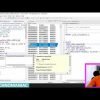This video discusses the advanced concepts of Core Data Services (CDS) in SAP HANA, specifically focusing on the use of Object Model and Ignore Propagated Annotations in CDS views. It provides a detailed explanation of these annotations and their significance in CDS views.
After watching this video, you will learn:
- The concept of metadata ignore propagated annotations. This annotation is used to control the inheritance of annotations from other CDS views. If set to true, the CDS view will not inherit annotations from other CDS views it references.
- The different types of annotations in CDS views, including direct annotations, metadata extension annotations, derived annotations, and inherited annotations. The presenter explains how these annotations are evaluated and their role in the functionality of CDS views.
- The use of the Object Model annotation, which includes three sub-annotations: data class, size category, and service quality. These annotations are used to define the characteristics of the data in the CDS view and its expected performance.
- The data class annotation is used to specify the type of data in the CDS view, such as master data, transactional data, customizing data, metadata, mixed data category, or organizational data.
- The size category annotation is used to specify the expected volume of data in the CDS view. It can be set to small, medium, large, extra large, or extra extra large, depending on the number of records the CDS view is expected to handle.
- The service quality annotation is used to specify the expected performance of the CDS view. It can be set to A, B, C, D, or P, with each letter representing a different level of performance and restrictions on the number of tables and functions that can be used in the CDS view.

































